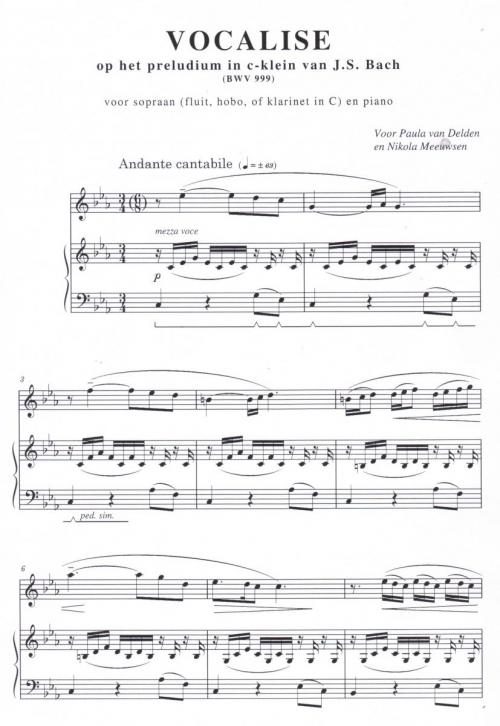AB II-06
Description
Albert Brussee
VOCALISE OP HET PRELUDIUM IN C-KLEIN VAN J.S. BACH
– for soprano (flute, oboe) and piano
– for piano two hands
Above J.S. Bach’s simple Prelude in C minor (‘Pour le luth’, BWV 999) a romantic melody is to be heard (without words) which can serve as a vocalise (study for the voice) due to its many technical and rhythmical complications. The present score is a new version of the original one, published in 1988 by Broekmans & Van Poppel in ‘composer’s handwriting’, whereby the performance possibilities have been extended. A version for solo piano (two hands) has been added.

Reviews
Pianist/composer Albert Brussee has recently brought to light two interesting, new compositions. The first of these is a Vocalise on the Prelude in C minor (‘Pour le luth’, BWV 999) by J.S. Bach. In this Brussee has written a technically challenging melody which, just as Gounod’s Ave Maria melody, unfolds above the prelude’s harmonic structure. Two versions have been included in the publication: one for soprano (flute, oboe) and one for solo piano. The melody is identical in both versions. For the solo pianist the challenge lies in smoothly combining the accompaniment and the melody. In his setting, Brussee plays with the relationship between the newly composed melody and the rhythm and harmonies of the underlying prelude. He does this through clever exploitation of the possibilities of interpreting the three-four meter (with semiquaver pulse) as six quavers or even four groups of three semiquavers. However, the rhythmic and harmonic tensions caused by this are not, in my opinion, always equally successful. At the end of the day the work is a welcome complement in the tradition of the many nineteenth-century vocalises: a technical exercise in the form of a ‘song without words’ upon an inspiring accompaniment by J.S. Bach.
Karst de Jong, Piano Bulletin 2013-1. (Translated from the Dutch)
In the tradition wherein Gounod built his Ave Maria on the first prelude of Bach’s The Well-Tempered Clavier (Book I), Albert Brussee has produced an equivalent work of art with a vocalise on the Prelude in C minor. Opinions on such an arrangement vary. For some it is sacrilege, for other an enrichment of Bach’s original. Whatever your opinion may be, the fact remains that Brussee has written an intriguing melody. At many places in the gesticulation unadulterated Baroque rhetoric is heard, which dovetails well into the dramatic development of the underlying Bach harmonies. But there is more. Above the prelude’s stable locomotion the melody’s accent shuttles to and fro between three and two beats in the bar (3/4 and 6/8, respectively). Because of the choice for a slow tempo the phrases of 6/8 bars take on the character of a Sicilian, whereby two Baroque forms are combined in a highly refined manner. The vocalise can be sung (the vocals are for that matter not dictated, which offers possibilities for variation in timbre), but can also be played on the flute or oboe. As a bonus, a version for solo piano is added. You could even play it as an organ trio.
Maarten Boonstra, PianoWereld 2013-2. (Translated from the Dutch)
Practical information
© 2012 AB Music Productions & Editions, The Hague.
12 pages.
Available through the usual music channels (distribution by Hal Leonard in Holland and Belgium) or direct from AB Music Productions & Editions.
€8.50
Above J.S. Bach’s simple Prelude in C minor (‘Pour le luth’, BWV 999) a romantic melody is to be heard (without words) which can serve as a vocalise due to its many technical and rhythmical complications. The present score is a new version of the original one, published in 1988 by Broekmans & Van Poppel in ‘composer’s handwriting’, whereby the performance possibilities have been extended. A version for solo piano (two hands) has been added.

 Nederlands
Nederlands 



Reviews
There are no reviews yet.